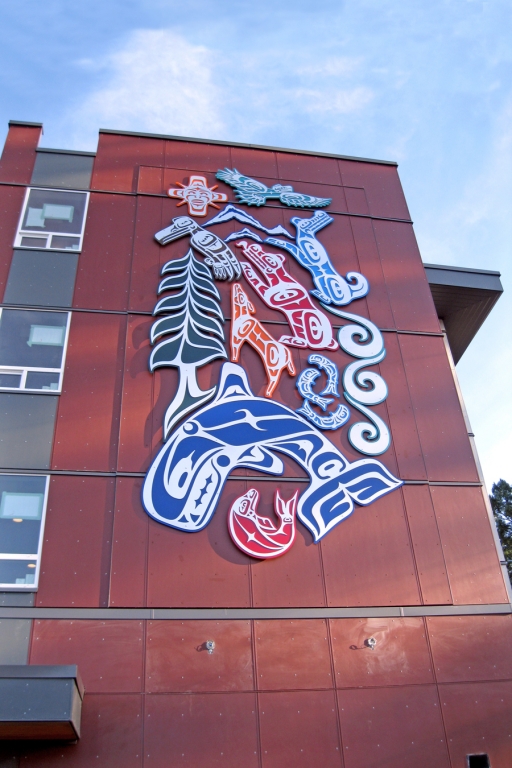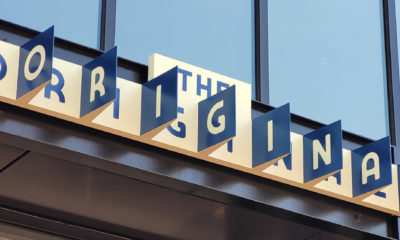“We had sold a job in ¼-in. brass before we had our first machine delivered and were able to wor kon a real job with the trainer beside us,” recalled Dan Hansen, CEO of D.H. Signs of the Times Enterprises Inc. (Victoria, BC, Canada), of the way his company started routing signs. Hansen had carefully planned his “route” to this point; his keen attention to details aided him as much in his router investment as it does in the intricate signs his company designs and fabricates today.
A router can mill textures, inlays and custom-shaped letters, as well as provide precision cutting for multiple pieces of a substrate to fit together accurately. In addition, a router can countersink, drill holes, cut out shapes and mill the background away for a “relief” or 3D appearance. Finally, all of this – according to Hansen –can be done at the same time, a huge savings in production. Hansen decides to use a router whenever 3D or intricate details are required, and estimates that 70% of all signs his company produces are routed.
If you are contemplating entry to the routed sign market and you missed Chris and Kathi Morrison’s excellent intro, “CNC Routers” (see ST Feb. 2017, pg. 30), please read it. (Also, for more details about carving itself, see “Strictly Commercial: Big Cat Comin’ at You” on pg. 48.)
AN ALUMINUM MURAL
Signs of the Times Enterprises routes urethane, plastics, aluminum and wood. In 2016, they produced a “dimensional mural” of artwork by Connie Watts for the M’akola Development Society building, four stories of residential units and office space. “The idea of placement was to elevate different pieces off the wall at different elevations and to add some dimensions,” Hansen said. High-contrast colors for the background and a clear anodized aluminum plate on top accomplished the dimensionality. For this, like many of their jobs, they rode their workhorse, a Pacer 4008 ATC router from AXYZ Intl.
“With double layers of aluminum, one for the background (color) and one for the front cut-out details, it was important to have accurate alignment,” Hansen said. “As the aluminum was only ¼-in. thick, the router could accurately mill the holes on the back side to an accurate depth and placement, making the assembly easier.” Precision was critical in this case, as a fine artist’s work was being represented. “It was also paramount to ensure complete accuracy as Connie Watts was very detailed about her expectations,” Hansen said.
Signs of the Times Enterprises relied on Gerber Omega and ARTPath™ software to program their router for the aluminum mural. Routing all the pieces for this project occupied approximately 40% of the total production, which also included setting up the files and tool paths, material handling, operating the machine, cleaning up, recycling and restocking leftovers. They used the Matthews Paint System to finish the aluminum and lifted the completed pieces utilizing a bucket truck. “Each piece was bolted to the wall and had to penetrate the inner timbers while [avoiding the building’s] flashing, which was running in both directions,” Hansen said. The result was a 3D mural that celebrates the traditional artwork of the urban Aboriginal families who reside in the development.
Advertisement
A ROUTE TO KNOWLEDGE
Hansen’s advice is to ask yourself if there’s a market in your area for routed signs. If so, then “do your homework, go to shows, compare the software and finishes, know the available options and ask each manufacturer about their training period,” Hansen said. “Negotiate for three days,” he added. “Most importantly, does the manufacturer stock parts for your machine and are they readily available? If your machine goes down, waiting on a part holds up production and upsets clients.”
Finally, Hansen suggests subcontracting routed signs first. “This way, you can build up this service and, once you have created a market and have significant sales, you can then invest in your own machine confidently.”
AN HDU PROJECTING SIGN
“Our router is our best friend and employee,” joked Manfred Didier, owner of Timber Signs OHG (Ofterschwang, Germany). With most of the work produced by his company being dimensional signs, you can understand why. “We mostly do 3D signs,” Didier said. “This means that we design most signs from the very beginning as 3D projects. These are [always destined] to be router jobs.” Didier estimates that around 80% of Timber Signs’ jobs are routed from CORAFOAM® HDU from DUNA-Corradini, with the rest spread among Corian, Sintra, Dibond, plywood and laminated wood.
Last year, Timber Signs designed and fabricated a dimensional projecting sign for Kessler, the local hardware store of a small town. Didier and his colleague, Marcus Goebels, designed the sign with the capabilities of their router in mind. “The shape isn’t straight,” Didier said. “This would take way too long by hand and the router does everything perfectly.” Therefore, the letters of the main copy were routed, and all the letters underneath the oval were engraved into the background. They did use chisels to clean away some of the HDU by hand. “Because of the diameter of some tools, the router leaves some marks we don’t want to have,” Didier added.
Timber Signs runs their Gerber Sabre 408 router on Gerber Omega software. Upon completing the routing, they coated the HDU with Jay Cooke Primer, then applied acrylic and 1 Shot paints. They mounted the sign to a smithed, welded and galvanized steel bracket and installed it above the main entrance to the store. The smooth, clean dimensional sign should welcome customers for years to come.
CNC = BFF?
Because Timber Signs uses their router for almost every project, it’s always a major part of the workflow. “After the design is proofed and all necessary files are prepared, we start with routing,” Didier said. “Every other step comes after.” Didier figures around 30-40% of an average project’s time is devoted to routing. “HDU can be routed very fast and easily,” Didier continued. “Some other much harder materials are very sensitive, which can end in damaged edges or even broken router bits.” Timber Signs’ pricing is based on the square feet and “elaborateness” of the design and it always includes the routing time.
Advertisement
“Many mistakes can be made by preparing the router files,” Didier said. “The router just follows the lines you create.” Choosing the right bits and parameters can make a huge difference, making the router and programmer a valuable team member, almost as much as the router itself.
Didier concurs that plenty of research both into the potential market for routed signs as well as routers and software themselves should precede any purchase. “Look for the right dimensions and quality,” Didier advised. “Price is always an issue but a cheap router with bad components can cost you much more over the years than a high-quality router.” Didier also suggests that a tool changer is nice to have, especially if you work with many different bits. Finally, a vacuum pump is a must-have to handle the prodigious dust and other material shavings created in the cutting process. “Use your router as much as possible,” Didier said, “and you will become best friends!”



 Tip Sheet2 weeks ago
Tip Sheet2 weeks ago
 Photo Gallery3 days ago
Photo Gallery3 days ago
 Ask Signs of the Times5 days ago
Ask Signs of the Times5 days ago
 Real Deal2 weeks ago
Real Deal2 weeks ago
 Paula Fargo18 hours ago
Paula Fargo18 hours ago
 Benchmarks1 week ago
Benchmarks1 week ago
 Photo Gallery18 hours ago
Photo Gallery18 hours ago
 Women in Signs2 weeks ago
Women in Signs2 weeks ago









